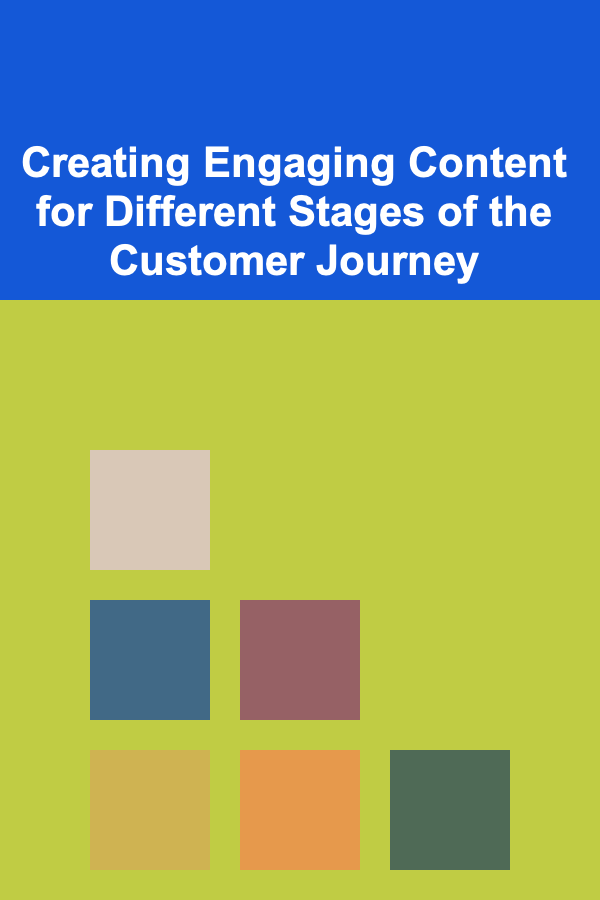
Creating Engaging Content for Different Stages of the Customer Journey
ebook include PDF & Audio bundle (Micro Guide)
$12.99$10.99
Limited Time Offer! Order within the next:

In today's digital landscape, content is king. But simply creating content isn't enough. To truly succeed, you need to craft engaging content that resonates with your audience at every stage of their journey. This journey, often referred to as the customer journey or buyer's journey, outlines the steps a potential customer takes from initial awareness of a problem or need to becoming a loyal advocate for your brand. Understanding these stages and tailoring your content accordingly is crucial for driving conversions and fostering long-term customer relationships.
Understanding the Customer Journey
The customer journey can be broadly divided into three main stages: Awareness, Consideration, and Decision. Some models expand this to include Retention and Advocacy, reflecting the importance of nurturing existing customers and turning them into brand ambassadors. Let's delve into each stage and explore the types of content that are most effective.
1. Awareness Stage
This is the top of the funnel, where potential customers are just beginning to realize they have a problem or need. They're looking for information, not necessarily a solution from you. Your goal here is to attract their attention and educate them about their problem, establishing yourself as a knowledgeable and trustworthy resource.
Characteristics of the Awareness Stage:
- Problem Recognition: The customer identifies a challenge, pain point, or opportunity.
- Information Gathering: They begin researching their problem and potential solutions (broadly).
- Brand Agnostic: They are not yet focused on specific brands or products.
Content Types for the Awareness Stage:
- Blog Posts: Informative and educational articles that address common problems or questions related to your industry. Focus on providing value and insights without being overly promotional. For example, if you sell project management software, a blog post titled "5 Common Project Management Challenges and How to Overcome Them" would be appropriate.
- Infographics: Visually appealing and easily digestible content that presents data or information in a compelling way. Infographics are great for summarizing complex topics or highlighting key statistics.
- Social Media Updates: Share engaging content, ask questions, and participate in relevant conversations on social media platforms. Use visually appealing images and videos to capture attention.
- Ebooks/Guides: Offer in-depth resources that provide comprehensive information on a specific topic. These can be gated (requiring an email address to download) to capture leads.
- Videos: Create short, informative videos that explain common problems or offer tips and tricks. These can be used on your website, social media, and YouTube. "Explainer videos" are particularly effective.
- Podcasts: Share audio content that provides valuable insights, interviews, or discussions related to your industry. Podcasts can establish you as a thought leader and reach a wider audience.
- Search Engine Optimization (SEO): Ensure your content is optimized for relevant keywords so that potential customers can easily find it when searching online.
Key Considerations for Awareness Stage Content:
- Focus on Education: Provide valuable information that helps customers understand their problem.
- Avoid Overly Promotional Content: Don't try to sell your product or service at this stage.
- Use Relevant Keywords: Optimize your content for search engines to attract the right audience.
- Make it Easily Shareable: Encourage users to share your content on social media.
- Consider Content Format: Offer content in a variety of formats to cater to different learning styles and preferences.
Example: Imagine you sell accounting software. For the awareness stage, you might create a blog post titled "The Top 5 Financial Mistakes Small Businesses Make." This post educates potential customers on common problems without directly selling your software. You could also create an infographic summarizing key financial ratios for small businesses. The goal is to be helpful and establish yourself as an authority on small business finance.
2. Consideration Stage
At this stage, potential customers have clearly defined their problem and are actively researching different solutions. They're comparing options, evaluating features, and looking for evidence that your product or service can meet their needs. Your goal is to demonstrate the value and benefits of your offering and differentiate yourself from the competition.
Characteristics of the Consideration Stage:
- Solution Exploration: The customer actively researches different solutions to their problem.
- Vendor Evaluation: They begin to compare different vendors and their offerings.
- Feature Comparison: They focus on specific features and benefits that are important to them.
Content Types for the Consideration Stage:
- Case Studies: Showcase how your product or service has helped other customers solve similar problems. Case studies provide real-world evidence of your value proposition.
- White Papers: Offer in-depth analyses of specific topics related to your industry and your solutions. White papers can be used to demonstrate your expertise and thought leadership.
- Webinars: Host online presentations or workshops that provide valuable information and demonstrate your product or service in action. Webinars are a great way to engage with potential customers and answer their questions.
- Product Demos: Offer free trials or demonstrations of your product or service. This allows potential customers to experience the benefits firsthand.
- Comparison Guides: Create guides that compare your product or service to competitors. Be fair and objective, highlighting your strengths and addressing any potential weaknesses.
- Datasheets: Provide detailed technical specifications and information about your product or service. This is particularly important for B2B audiences and those with specific technical requirements.
- Expert Interviews: Feature interviews with industry experts who can provide insights and validate your claims.
Key Considerations for Consideration Stage Content:
- Focus on Benefits: Highlight the specific benefits that your product or service offers.
- Provide Social Proof: Use case studies, testimonials, and reviews to demonstrate your credibility.
- Address Objections: Anticipate and address common objections or concerns that potential customers may have.
- Differentiate Yourself: Clearly articulate what makes your product or service unique and better than the competition.
- Use Strong Calls to Action: Encourage potential customers to take the next step, such as requesting a demo or downloading a free trial.
Example: Continuing with the accounting software example, for the consideration stage, you might create a case study showcasing how your software helped a small business streamline its accounting processes and improve its cash flow. You could also host a webinar demonstrating the key features and benefits of your software. A comparison guide highlighting how your software stacks up against competitors like QuickBooks or Xero would also be effective.
3. Decision Stage
At this stage, potential customers are ready to make a purchase decision. They've narrowed down their options and are looking for the final push to choose you. Your goal is to provide them with the information and confidence they need to make a decision, focusing on overcoming any remaining doubts or hesitations.
Characteristics of the Decision Stage:
- Vendor Selection: The customer has narrowed down their options and is choosing a vendor.
- Pricing and Packaging: They are focused on pricing, payment options, and service agreements.
- Final Review: They are seeking reassurance that they are making the right decision.
Content Types for the Decision Stage:
- Pricing Pages: Clearly display your pricing options and highlight any discounts or special offers. Make sure your pricing is competitive and transparent.
- Free Trials/Demos: Offer a free trial or demo of your product or service to allow potential customers to experience its value firsthand.
- Customer Testimonials: Feature compelling testimonials from satisfied customers. Testimonials can help overcome any remaining doubts or hesitations. Video testimonials are particularly powerful.
- Product Comparisons (detailed): Provide detailed comparisons of your product or service to competitors, highlighting your key differentiators and addressing any potential concerns. This might include head-to-head feature comparisons.
- Money-Back Guarantees: Offer a money-back guarantee to reduce the risk of purchase. This can help build trust and confidence.
- Consultations/Assessments: Offer free consultations or assessments to help potential customers determine the best solution for their needs.
- Sales Collateral: Provide brochures, datasheets, and other sales materials that summarize the key benefits of your product or service.
- FAQ Pages: Address common questions and concerns about your product, service, and the buying process.
Key Considerations for Decision Stage Content:
- Focus on Value: Reinforce the value that your product or service provides and justify the price.
- Provide Clear Pricing: Make your pricing transparent and easy to understand.
- Offer Incentives: Offer discounts, bonuses, or other incentives to encourage a purchase.
- Address Final Concerns: Address any remaining questions or concerns that potential customers may have.
- Make it Easy to Buy: Simplify the purchase process and make it easy for customers to buy from you.
Example: For the decision stage of the accounting software example, you would focus on providing clear pricing information, offering a free trial of your software, and showcasing compelling customer testimonials. You might also offer a personalized consultation to help potential customers determine the best plan for their needs. Providing a detailed FAQ page addressing common questions about pricing, features, and support would also be beneficial.
4. Retention Stage
The journey doesn't end after the purchase. Retaining customers is crucial for long-term success. This stage focuses on nurturing existing customers, providing ongoing support, and encouraging repeat business. Content should focus on maximizing the value they receive from your product or service.
Characteristics of the Retention Stage:
- Product Usage: The customer is actively using your product or service.
- Value Realization: They are experiencing the benefits they expected.
- Customer Satisfaction: They are satisfied with their overall experience.
Content Types for the Retention Stage:
- Onboarding Materials: Provide comprehensive onboarding materials to help new customers get started with your product or service.
- Training Videos/Tutorials: Create videos and tutorials that explain how to use your product or service effectively.
- Knowledge Base/FAQ: Develop a comprehensive knowledge base or FAQ section that answers common questions and provides troubleshooting tips.
- Customer Support: Provide excellent customer support through various channels, such as email, phone, and live chat.
- Newsletters: Send regular newsletters with tips, updates, and exclusive offers.
- Community Forums: Create a community forum where customers can connect with each other and share their experiences.
- Loyalty Programs: Reward loyal customers with exclusive benefits and discounts.
- Personalized Content: Tailor content to individual customer needs and preferences.
- Surveys and Feedback Forms: Gather feedback from customers to identify areas for improvement.
Key Considerations for Retention Stage Content:
- Focus on Customer Success: Help customers achieve their goals with your product or service.
- Provide Excellent Support: Offer prompt and helpful customer support.
- Engage with Customers: Communicate with customers regularly and build relationships.
- Personalize the Experience: Tailor content and offers to individual customer needs.
- Gather Feedback: Continuously solicit feedback and use it to improve your product or service.
Example: For the retention stage of the accounting software example, you would provide excellent customer support, create helpful training videos and tutorials, and send regular newsletters with tips and updates. You might also offer a loyalty program to reward customers for their continued business. Sending personalized emails with tips based on their usage of specific features would be beneficial.
5. Advocacy Stage
This is the final stage, where satisfied customers become advocates for your brand. They recommend your product or service to others, write positive reviews, and share your content on social media. Your goal is to encourage and empower these advocates.
Characteristics of the Advocacy Stage:
- Brand Loyalty: The customer is a loyal advocate for your brand.
- Positive Reviews: They write positive reviews and testimonials.
- Referrals: They refer new customers to your business.
Content Types for the Advocacy Stage:
- Referral Programs: Offer incentives for customers to refer new customers to your business.
- Social Media Engagement: Encourage customers to share their experiences on social media.
- Review Requests: Ask satisfied customers to write reviews on relevant platforms.
- User-Generated Content: Showcase user-generated content, such as photos, videos, and testimonials.
- Exclusive Offers: Provide exclusive offers and discounts to loyal customers.
- Community Building: Foster a strong sense of community among your customers.
- Case Studies (with advocates): Collaborate with your advocates to create compelling case studies.
- Early Access: Give loyal customers early access to new features or products.
Key Considerations for Advocacy Stage Content:
- Make it Easy to Share: Provide tools and resources that make it easy for customers to share your content and refer new customers.
- Recognize and Reward Advocates: Show appreciation for your advocates and reward them for their efforts.
- Engage with Advocates: Communicate with your advocates regularly and build relationships.
- Listen to Feedback: Pay attention to feedback from your advocates and use it to improve your product or service.
- Create a Community: Foster a strong sense of community among your advocates.
Example: For the advocacy stage of the accounting software example, you would offer a referral program, encourage customers to write reviews, and showcase user-generated content on your website and social media. You might also feature case studies highlighting the success of customers who are actively advocating for your software. Creating a Facebook group where customers can connect and share tips would also be beneficial. Offering exclusive beta access to new features for your most loyal customers fosters a sense of value and community.
General Tips for Creating Engaging Content
Beyond tailoring content to specific stages of the customer journey, there are several general best practices to keep in mind when creating engaging content:
- Know Your Audience: Understand their needs, interests, and pain points. Develop detailed buyer personas to guide your content creation efforts.
- Write Compelling Headlines: Your headline is the first (and often only) thing people will see. Make it attention-grabbing and relevant.
- Use High-Quality Visuals: Images and videos can significantly enhance engagement. Use professional-quality visuals that are relevant to your content.
- Tell Stories: People connect with stories on an emotional level. Use storytelling to illustrate your points and make your content more memorable.
- Make it Readable: Use short paragraphs, bullet points, and subheadings to make your content easy to scan and read.
- Use a Conversational Tone: Write in a way that feels natural and engaging. Avoid jargon and technical terms that your audience may not understand.
- Optimize for Mobile: Ensure your content is optimized for mobile devices, as a significant portion of your audience will be accessing it on their smartphones or tablets.
- Promote Your Content: Don't just create content and expect people to find it. Actively promote it through social media, email, and other channels.
- Analyze and Iterate: Track the performance of your content and use the data to improve your future efforts. Pay attention to metrics such as page views, engagement, and conversions.
- Be Authentic: Be genuine and transparent in your content. People can spot insincerity, and it will damage your credibility.
Conclusion
Creating engaging content for different stages of the customer journey is essential for attracting, converting, and retaining customers in today's competitive market. By understanding the needs and motivations of your audience at each stage, you can create content that resonates with them and drives meaningful results. Remember to focus on providing value, building trust, and fostering long-term relationships. By implementing the strategies outlined in this article, you can create a content marketing strategy that delivers a significant return on investment.

How to Make Money Online as a Stage Manager: 10 Actionable Ideas
Read More
How to Set Up a Scrap Fabric Storage System
Read More
How To Understand the Basic Steps of Wine Tasting
Read More
Creating Designs for POD Accessories: Totes and Bags
Read More
How to Research an Art Exhibition Before You Go: A Preparation Checklist
Read More
How to Ace Your Pharmacy Technician Certification Exam
Read MoreOther Products

How to Make Money Online as a Stage Manager: 10 Actionable Ideas
Read More
How to Set Up a Scrap Fabric Storage System
Read More
How To Understand the Basic Steps of Wine Tasting
Read More
Creating Designs for POD Accessories: Totes and Bags
Read More
How to Research an Art Exhibition Before You Go: A Preparation Checklist
Read More